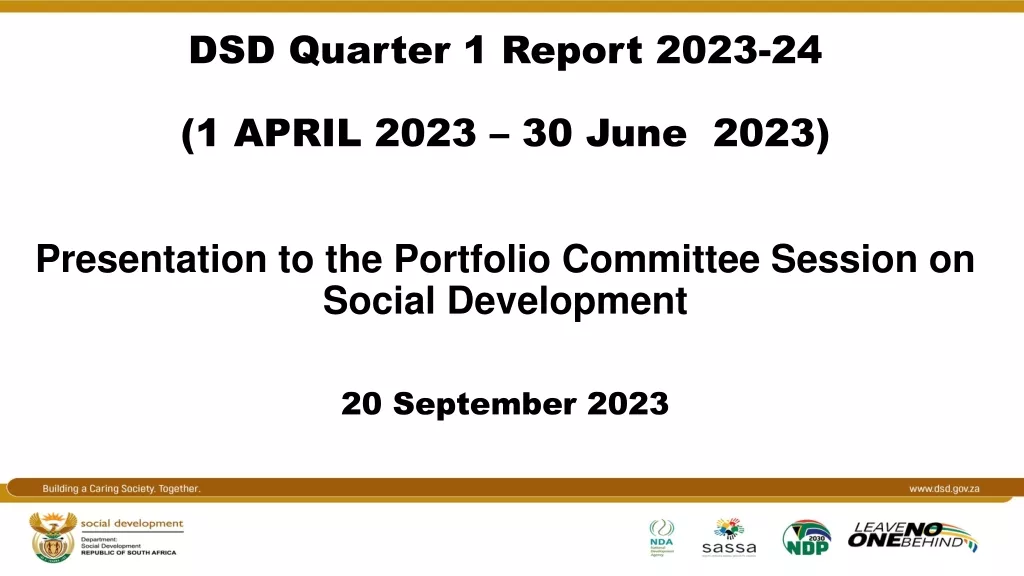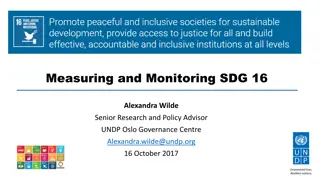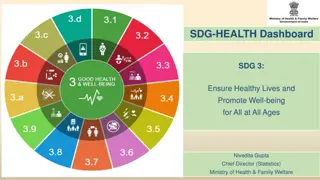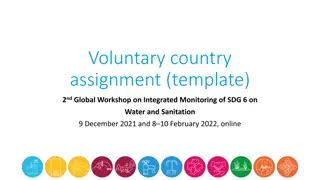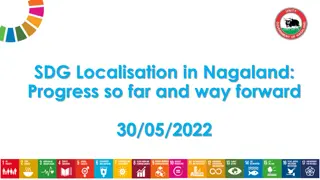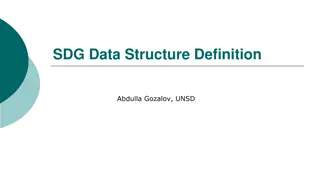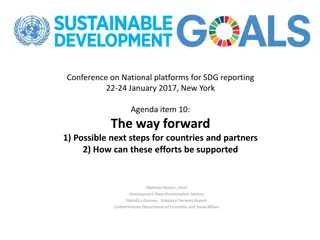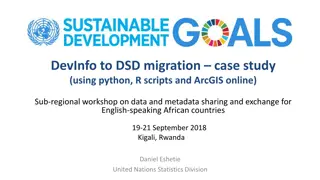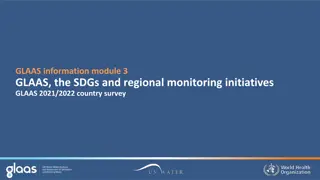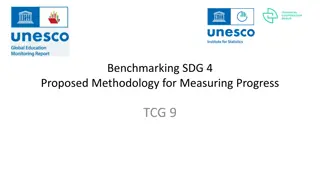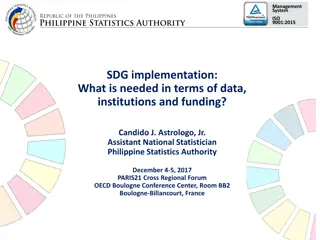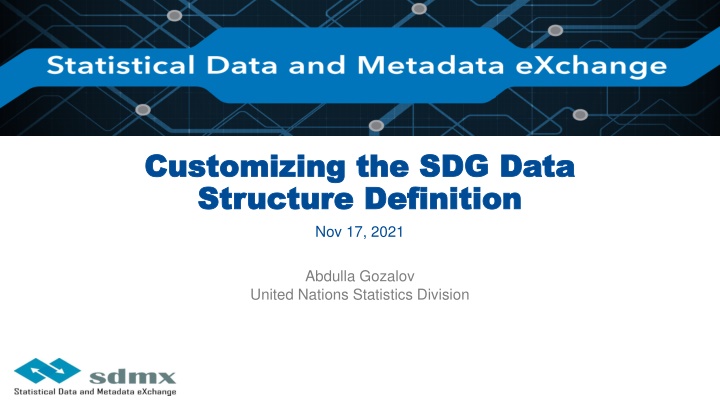
Customizing the SDG Data Structure for National Use
Learn about customizing the SDG data structure for national use, including guidelines for customization, national SDG DSDs, and the importance of high-quality and disaggregated data in achieving the Sustainable Development Goals by 2030.
Download Presentation

Please find below an Image/Link to download the presentation.
The content on the website is provided AS IS for your information and personal use only. It may not be sold, licensed, or shared on other websites without obtaining consent from the author. If you encounter any issues during the download, it is possible that the publisher has removed the file from their server.
You are allowed to download the files provided on this website for personal or commercial use, subject to the condition that they are used lawfully. All files are the property of their respective owners.
The content on the website is provided AS IS for your information and personal use only. It may not be sold, licensed, or shared on other websites without obtaining consent from the author.
E N D
Presentation Transcript
Customizing the SDG Data Customizing the SDG Data Structure Definition Structure Definition Nov 17, 2021 Abdulla Gozalov United Nations Statistics Division
Sustainable Development Goals From the United Nations General Assembly resolution 70/1 Transforming our world: the 2030 Agenda for Sustainable Development 74. Follow-up and review processes at all levels will be guided by the following principles: (g)They will be rigorous and based on evidence, informed by country-led evaluations and data which is high-quality, accessible, timely, reliable and disaggregated by income, sex, age, race, ethnicity, migration status, disability and geographic location and other characteristics relevant in national contexts. The requirement that SDGs support any relevant characteristics means that the SDG DSD must be customizable. Countries must be able to add national indicators and disaggregation to the Global DSD. 2
Global SDG DSD Based on data submitted by Custodian Agencies to the Global SDG Database. Includes series and disaggregation approved by the IAEG-SDGs. Includes M49 and ISO-3611 reference area codes at the national and supranational levels. Custodian agencies submit proposed updates to the metadata to the IAEG- SDGs for approval. Once approved, the series/disaggregation are added to the global SDG DSD and published in the global SDG database. 3
National SDG DSDs National SDG Indicator Frameworks are developed to account for national priorities. Additional indicators Additional series for global indicators Additional disaggregation Sometimes, additional targets or even goals The global SDG DSD does not include nation-specific indicators and disaggregation To disseminate national SDG indicators in SDMX, the global SDG DSD must be customized for national use. 4
Guidelines for the Customization of the Global SDG DSD Recommendations on how to customize the global SDG DSD for national use. Developed by the SDMX-SDGs Working Group and published at the SDMX- SDGs Working Group page. First published Jan 2020, latest release 1.6 published Oct 2021. 5
Ownership of SDMX Artefacts Any change to the global DSD must entail the transfer of ownership of affected artefacts to the organization that makes the change. For example, if Cambodia wants to add national indicators to the global DSD: 1. Set KH_NIS (Cambodia National Institute of Statistics) as the maintenance agency of the code list CL_SERIES. 2. Add national indicators to the code list CL_SERIES. 3. Set KH_NIS as the maintenance agency of the SDG DSD. 4. In the DSD, update dimension SERIES to point to reference to the nationally code list CL_SERIES. 5. Create or update dataflows that use the SDG DSD. The versioning process must always be followed to ensure that updated artefacts do not conflict with any existing or future releases of global SDMX artefacts. 6
Customize the global SDG DSD when 1. National indicator framework includes indicators that are not part of the global DSD, or series for global indicators that are not part of the global DSD. 2. Breakdowns of indicators reported by the country use codes that are not part of the global DSD. For example, a country needs to add its provinces to the global Reference Area code list. 3. The indicators are disaggregated using breakdowns that are not part of the global DSD. For example, a country needs to add a breakdown by ethnicity, which is not part of the global DSD. 4. Additional information is transmitted that is not expressed in the concepts of the global DSD. 7
Adding codes to SDG code lists Prefix _L is generally recommended when adding local extensions to global code lists When adding global codes from another global code list, prefix is not required E.g. AGE, as explained later 8
Adding national indicators Add to the CL_SERIES code list The following format is recommended: _L_[ISO Alpha2 Country Code]_[2-char Goal][2-char Target][2-char Indicator]_[2-char Series] For example, the following codes were added for Kyrgyzstan: _L_KG_060402_1 Freshwater withdrawal _L_KG_070301_1 Energy intensity of GDP by industry _L_KG_070301_2A Power intensity of GDP by industry The last part of the code ( 2-char Series ) is used to differentiate between different series that belong to the same national indicator. 9
Reference Area (CL_AREA) Global code list CL_AREA only includes entries at national level and above. To add subnational areas, it is recommended to use the country s ISO3166 code followed by subdivision code. Subdivision codes may follow the ISO3166-2 standard or another coding system used in the country. For example, subnational codes for Kyrgyzstan include: KG05 Batken KG11 Bishkek (city) KG08 Chui 10
Age (CL_AGE) Global code list captures most commonly used age groups. Add age groups following the recommendation of the SDMX Statistical Working Group. Y40T59 40 to 59 years old Y_GE35 35 years old and over M0T5 under 6 months old It is recommended not to use LT and LE ( less than , less than or equal ) and use a bounded age range instead. For example, use Y0T20 for Under 21 years of age . It is recommended not to use GT ( greater than ) and instead use GE ( greater than or equal ). For example, use Y_GE65 for 65 years old and over and over 64 years old . 11
Economic activity (CL_ACTIVITY) Global SDG code list includes top-level ISIC4 codes, which are prefixed accordingly e.g. ISIC4_A, ISIC4_C. Additional ISIC4 codes can be added using prefix ISIC4. If ISIC3 codes need to be added, use prefix ISIC3. National variants of ISIC should be prefixed with _L: _L_ [National Code] 12
Education level (CL_EDUCATION_LEV) Global SDG Code list includes top-level ISCED97 and ISCED11 codes, as well as custom codes used in SDG indicators. Additional codes can be added, to the extent possible, from more detailed global Education Level code lists published at the SDMX Global Registry. National variants should be prefixed with _L: _L_ [National Code] 13
Occupation (CL_OCCUPATION) Global SDG code list for occupation includes entries from ISCO-08, ISCO-88, and ISCO-68 classifications, as well as SDG-specific entries. The codes use prefixes that indicate their classifications. Detailed ISCO-08 global code list is available at the SDMX Global Registry. Use prefix ISCO08 if importing codes from this code list. National variants should be prefixed with _L: _L_ [National Code] 14
Product or commodity type (CL_PRODUCT) Global SDG code list includes several types of codes, used in various global SDG indicators: Material flow codes imported from the global SEEA DSD. Additional codes can be imported from the code list CL_MATERIAL published at the SDMX Global Registry. Central Product Classification (CPC) product codes imported from the global IMTS DSD. Additional CPC codes can be imported from the code list CL_COMMODITY published at the SDMX Global Registry. Custom SDG codes. 15
Aggregated codes Sometimes, data from several categories need to be aggregated and presented as one observation. In that case, a new code is required, which is a combination of several underlying codes. The recommendation is to combine codes as follows: "T" to express ranges (e.g. from 3 to 9) with more than 2 codes. Combination of codes using _ should be used when 2 consecutive codes are combined. "_" to combine two codes, whether consecutive or not (e.g. 5 and 6; A and F), and also for a list of more than two non-consecutive codes. "X" for expressing "except" or "excluding", "GT" for "greater than", "LT" for "less than", "GE" for "equal to or greater than" and "LE" for "equal to or less than". 16
Aggregated codes (2) Examples from the current SDG DSD: Code Name Rule ISIC4_C10T32X19 (CL_ACTIVITY) Manufacturing excl. coke and refined petroleum products and repair and installation of machinery and equipment Nursing and midwifery personnel Sum of ISIC4 codes C10 through C32 minus C19 ISCO08_222_322 (CL_OCCUPATION) Sum of ISCO08 codes 222 and 322 ISCED11_25_35_45 (CL_EDUCATION_LEV) Vocational secondary education Sum of ISCED11 codes 25, 35, and 45 17
Adding breakdowns National indicators may be disaggregated using breakdowns that are not part of the global DSD. There are 3 main methods of adding a breakdown to the DSD: Use the SERIES dimension. Use the COMPOSITE_BREAKDOWN dimension. Use the CUST_BREAKDOWN dimension. Each method is best suited for certain circumstances. 18
Adding a breakdown using SERIES A breakdown can be implemented through the SERIES dimension by adding a separate series code for each breakdown category for each indicator disaggregated by the breakdown. Example from the Global DSD: SG_XPD_HLTH Proportion of total government spending on essential services, health [1.a.2] SG_XPD_PROT Proportion of total government spending on essential services, social protection [1.a.2] SD_XPD_ESED Proportion of total government spending on essential services, education [1.a.2] This method works best when applied to a very small number of indicators (1- 2) and small number of codes. 19
Adding a breakdown using COMPOSITE_BREAKDOWN The COMPOSITE_BREAKDOWN dimension, and its CL_COMP_BREAKDOWN code list, are used to represent multiple breakdowns in the global DSD, and can be used to add national breakdowns. Use the following format: [breakdown abbreviation]_[ code] Example from Cambodia s DSD: SL_KEROSENE_LAMP Source of light: Kerosene lamp SL_CANDLE Source of light: Candle SL_BATTERY Source of light: Battery Warning: only one breakdown at a time can be used when using COMPOSITE_BREAKDOWN. Only add codes when a collision with other breakdowns in the code list is unlikely. 20
Adding a breakdown using CUST_BREAKDOWN Custom breakdown is intended to be used with volatile breakdowns that lack international or even national classifications and can change often. Names of codes are generic ( Custom code 1 , Custom code 2 ), and the meaning of each code is defined at the time the dataset is created, using the CUST_BREAKDOWN_LB attribute. The use of CUST_BREAKDOWN does not require any change to the DSD or transfer of artefacts ownership. However, CUST_BREAKDOWN is more difficult to use because the meaning of codes is not defined in the DSD, and the same code can have different semantics between different datasets based on the same DSD. 21
Modifying the data model Adding concepts or changing their role should not be necessary in most situations since additional indicators, codes, and breakdowns can be added as described earlier. Dimensions and attributes can be added or removed when compatibility with the conceptual model of the Global DSD is not required, e.g. to create local DSDs optimized for visualization. 22
THANK YOU! For further information, please refer to the Guidelines for the Customization of the Global SDG DSD. 23




